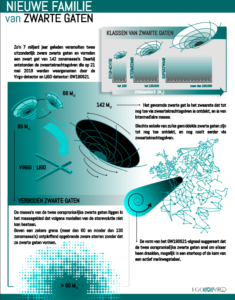An astrophysical first for gravitational wave detectors Virgo and LIGO. The detector in Italy and the two detectors in the US have found direct evidence of the existence of medium black holes in the Universe. The research teams conclude this from a space-time vibration that was collected on May 21, 2019.
Today the researchers publish two articles analyzing the signal called GW190521. The space-time vibration, according to those analyzes, comes from two merging black holes estimated to be 66 and 85 times the mass of the sun. This created a new black hole about 142 times the mass of the sun.
The cosmic collision took place 7 billion years earlier, deep in the universe. About 9 solar masses were instantly converted into space-time vibrations that would eventually reach Earth as well.
The estimated masses of the two initial black holes are outside the mass range that is possible according to the theory for stellar evolution. The resulting black hole of 142 times the mass of the Sun is the most massive ever seen directly with telescopes or detectors like Virgo.
Theories
The researchers’ conclusion is important for astrophysical theories of the formation of black holes, both relatively light from collapsing burnt-out stars and the supermassive black holes at centers of many galaxies. A black hole is a space-time defect that originates around an extremely compact mass. Even light cannot escape from such an area.
Gravitational waves are vibrations of space itself, which, according to Einstein’s theory of relativity, arise from extreme collisions of large masses. Such subtle vibrations were first measured in 2015 with the two LIGO detectors in the US, in Washington and Louisiana. Virgo from the EGO laboratory in Pisa was also involved in the first sighting.
Nikhef is one of the partners in the Virgo project and Nikhef researchers such as Sarah Caudill and Chris Van Den Broeck and their post-docs collaborated intensively on the new publications. Gravitational wave detectors measure extremely small and short-lived range variations between large mirrors three (Virgo) or four (LIGO) kilometers away with interfering laser light.
Short and sweet
Collisions of black holes in the Universe have been observed frequently since 2015, but never with such large initial masses and such a heavy end result. The GW190521 signal was therefore exceptionally short and strong, compared to other observations. That makes its interpretation complicated.
Two scientific papers reporting its discovery and its astrophysical implications were published today in Physical Review Letters and Astrophysical Journal Letters, respectively.
These initial black holes challenge astrophysical models describing the collapse of the most massive stars into black holes. According to these models, the heaviest stars are completely torn apart by the supernova explosion and therefore leave behind only gas and cosmic dust.
That is why astrophysicists would not expect a black hole in the mass range between about 60 and 120 solar masses: precisely the mass range in which the most massive initial black hole of GW190521 lies.
Mass gap
The detection thus provides a new view of massive stars and the mechanisms behind supernovae. “Different scenarios predict the formation of black holes in the so-called ‘pair instability mass gap’: they can be the result of the merging of smaller black holes or of the collision of (multiple) massive stars or even of more exotic processes,” says Michela Mapelli from the University and INFN of Padova, and a member of the Virgo Collaboration.
Analyzes and models now suggest that the initial black holes rotated on their own axis at high speed, so-called “spins”. “The signal shows hints of precession, a rotation of the orbital plane produced by spins of large magnitude and orientation,” said Tito Dal Canton, CNRS researcher at IJCLab in Orsay, France, and a member of the Virgo Collaboration.
“The effect is faint and we cannot say with certainty that it is present. But if true, this would support the hypothesis that the initial black holes formed in a very shaky and crowded cosmic environment, such as a star cluster or the accretion disk. of the core of a galaxy. ”
Primordial black holes
Compared to previous gravitational wave detections, the observed GW190521 signal is very short in time and more difficult to analyze. Other scenarios are also in line with the results shown, such as the hypothesis that the initial black holes of the amalgamation could be so-called primordial black holes: black holes that arose in the very early universe before stars even existed.
Other more exotic sources have also been considered, and these possibilities are described in an accompanying publication. However, these options are considered less likely, especially since the end product of the amalgamation was another black hole.

